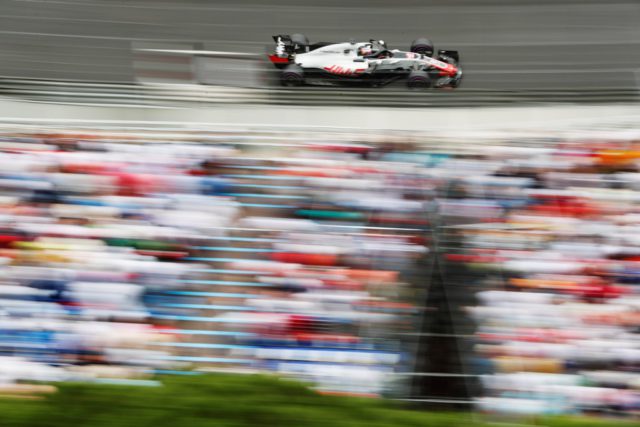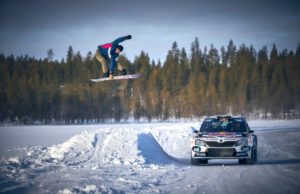Romain Grosjean calls Suzuka his “most favourite track in the world” and his Haas teammate Kevin Magnussen terms it “a driver’s track”. The duo scored Haas F1 Team’s second double-points result in last year’s Japanese Grand Prix, with Magnussen finishing eighth and Grosjean right behind in ninth. It was Magnussen’s best finish in three career Formula One starts at Suzuka and Grosjean’s third top-10 effort at the track, a history highlighted by his performance in the 2013 Japanese Grand Prix where Grosjean led 26 laps before finishing third behind the dominant Red Bulls of Sebastian Vettel and Mark Webber.
Haas F1 Team confirmed its driver lineup before the Russian Grand Prix, with you and Magnussen returning for another season. How helpful is it to have your future set and not a distraction as you battle for fourth in the constructors’ standings?
“It’s always good to know what your future’s like. For us, it’s great that it’s been confirmed. It’s a positive thing. We’re looking forward to the future.”
Haas F1 Team has made great strides from last year to this year. How much of that is attributable to having a consistent driver lineup, and do you expect that to deliver continued dividends in 2019?
“There is the driver lineup, which is important, and there is the engineering group, which is getting stronger and stronger and gaining more experience. Altogether, that means today we’re in a much better situation.”
You go from one of the smoothest tracks in Formula One – the Sochi Autodrom – to one of the roughest tracks in Suzuka Circuit. How does the weathered asphalt of Suzuka change your preparation in comparison to what you did for Sochi?
“Sochi is a particular racetrack – not one of my favourites. Suzuka is definitely my favourite. I always look forward to going there. We want to do well everywhere. We’re going to fight as hard as we can everywhere to get those points and try to beat Renault.”
After two straight races where the softest tire in Pirelli’s lineup was used – the Pink hypersoft – we’re back to a more traditional White medium, Yellow soft and Red supersoft tire combination. After struggling to sort how much longevity you could get from a set of hypersofts, is it advantageous to get back to a tire lineup you know well where each tire compound is only a step away from one another in terms of grip level?
“I don’t know. We’ll find out in Suzuka. Definitely the hypersoft is a great qualifying tire, but not such a good tire for the race.”
You’ve been quoted as saying that Suzuka is your most favorite track in the world. Why?
“It’s always difficult to say exactly why. I think it’s the flow, the corners, the high-speed nature of the track. There’s a risk, as well, with all the gravel and the narrow parts of the circuit. Overall though, it’s not one thing, and sometimes you don’t know why you like something, you just do.”
You led 26 laps in the 2013 Japanese Grand Prix at Suzuka before finishing third. Those are the most laps you’ve led at any Formula One venue. Talk about that race and how you were able to run out front for so long.
“I was fourth on the grid and made a really good start. I led from the first corner. Then Red Bull played its strategy. They put one car on a two-stop (strategy) and the other on a three-stop strategy. We led 26 laps, but we lost position to them. It was great, though. I remember telling myself to not go out as all the world’s TVs were on me. It was a great feeling to be leading. I loved it. I remember going to the train station after the race and it was packed with all the fans. It was hectic but memorable.”
There seems to be a delicate balance at Suzuka in regard to downforce. Too much and you go slowly down the straights. Too little and you won’t have the confidence to attack the track’s twists and turns. Obviously, the level of downforce is predicated on how comfortable you are at speed. How do you achieve this balance?
“It’s one of those tracks where you need quite a lot of downforce and a really good car in the high-speed corners. There are some important low-speed ones, as well. It’s about getting the right confidence in being able to push to the limit in those tricky sector-one turns. It’s not an easy track to set up the car, but definitely, a really good one to be on.”
Understeer through the esses between turns three and seven is often at the top of the to-do list at Suzuka. How do you address understeer and at what point does a change to help the car in one section of the track hurt it in another section?
“It’s a fine line. If you start getting understeer too early, you’re out of the phase quite early onto turns three, four, five, six, seven and eight. If you start with oversteer, it’s bad as well. There’s a fine line in having the right balance there, and to not be too far off what you should have in the low-speed corners as well.”
Would you call Suzuka a driver’s track?
“Definitely.”
Can the driver make more of a difference at Suzuka than at some other tracks?
“Not really, unfortunately. It’s about finding the right balance with the car. Your car’s performance dictates your performance at the end. It’s more or less the same everywhere. You can try to drive around and be quite consistent more easily than at other tracks.”
Where are the overtaking opportunities at Suzuka?
“Definitely at turn one with the DRS. There’s also big braking at the chicane at the last corner. There’s the middle hairpin too where you can have a go on the braking.”
What is your favourite part about Suzuka?
“Very difficult to pick just one, but I’ll go for sector one.”
Describe a lap around Suzuka.
“Turns one and two are very high-speed on entry. They’re long corners with a tricky exit. Sector one has a flow of corners where you really want to keep the perfect line all the way through, with the tricky one being turn seven and eight going up the hill on traction. Then you have a double right-hand corner, very high-speed one, very tricky exit curb in between. Then you go underneath the bridge with big braking into the hairpin. Traction is always important in going to Spoon corners. Same stuff here as turn one – very high-speed entry, going down to the second part with a very important exit which then leads to the big backstraight. Then it’s 130R flat out followed by big braking for the last chicane with a very tricky throttle application.”
Beyond the racetrack, what is most often talked about at Suzuka is the passion its fans have. Can you describe the atmosphere at the track and the fervency Japanese fans have for Formula One?
“It’s a pretty crazy atmosphere from Thursday onward. All the grandstands are full. After the race, they’re still there watching the replays of the grand prix on the big screens. They always have really cool fashions on display, with some crazy accessories. They love Formula One and they’re very passionate. It’s a very electric atmosphere. It’s great to see that passion and so many people cheering for teams like us.”
Japan has some fantastic and unique cuisine. What is your favourite?
“When we speak about Japan, everyone brings up sushi first. There’s much more to the country than just that. There’s some great meat, great fish. The techniques there are very different than French gastronomy. It’s very delicate. I love it.”
When you leave Japan you’ll be gearing up for Haas F1 Team’s home race – the United States Grand Prix in Austin, Texas. Where do you want Haas F1 Team to be heading into that event?
“I would love to get there and be fourth in the contructors’ championship and strengthen our advantage over the others.”
Take a look back at a few of our favorite ?? from the #RussianGP.
Which photo do you like the best? pic.twitter.com/4URpR2oFYd
— Haas F1 Team (@HaasF1Team) October 1, 2018
































